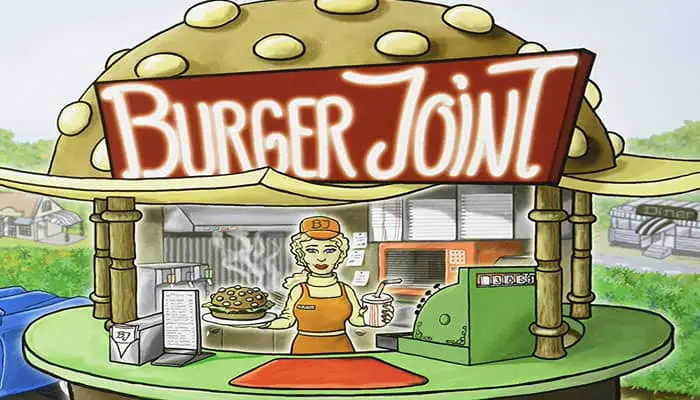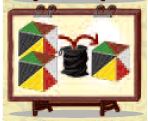
Components

- 60 Cubes representing food types
- 1 Bag for the cubes
- 1 Burger player development board
- 1 Pizza player development board
- 1 Resource allocation and storage board
- 30 Development Tokens
- 2 Tv-shaped Publicity Markers
- 2 Placard-shaped Scoring Markers
- Instructions
Object of the Game
Players compete to be the first to earn 12 victory points.
Game Board Description
Development Board

Each development board is divided into four columns. The top of each column ( ) indicates the building cost.
) indicates the building cost.
-

The first column indicates the amount of publicity this player has purchased. Once the first publicity has been bought, the publicity marker is placed on the first space in this column.
As additional publicity is bought, this token is moved down the track.
-

The second column shows this player's basic restaurants. The number of basic restaurants a player has will vary during the game; one token is used to indicate each one owned.
When an additional basic restaurant is built, it is placed in the highest open space in this column. Victory points are earned for the third, fifth, and sixth basic restaurant owned, as indicated on the board.
-

The third column indicates this player's specialty diners. Each diner owned is indicated by a token.
To build these diners, a player must upgrade a basic restaurant. He moves the token from the lowest occupied space in the basic restaurant column to the diner being purchased, and pays the four cubes indicated.

Each specialty diner is worth one victory point. In addition, each specialty diner entitles the owner to choose one cube per turn (limit of four), and to priority in selecting cubes of the color shown.
-

The fourth column indicates this player's upscale bistros. Each bistro owned is indicated by a token.
To build these bistros, a player must upgrade a specialty diner, paying the six cubes indicated and moving the development token from any existing diner.


Each upscale bistro is worth 0-3 victory points as shown. Bistros also entitle the owner to choose one cube per turn (again, to the limit of four) and provides a special ability on the player's turn.
Resource Board

The resource board is shared by the two players and is used for allocating cubes, storing cubes, and tracking victory points. The resource board is divided into five areas.
1 The central area on the resource board is used to allocate cubes. It is divided into three areas: a general area which either player may choose from, and a Burger and a Pizza area where only the matching player may draw from.
Each player has a 2 storage area in the corner of the central board. This is divided into an area for cubes taken a in the current production phase, and b the main area for cube storage.
Seven cubes are shown in the main area because at the end of each player's turn, only seven cubes may be kept; otherwise, players are not limited in the number of cubes they may have in storage.
Each player has a scoring track on the edge of the central board. Each player updates his scoring track after the building phase when he is the active player.
Setup
Each player takes a development board, all the matching development tokens, and the matching publicity marker. The player choosing Burgers places three tokens on the spaces marked to indicate possession of a burger joint and on the diners specializing in black and yellow.
The player choosing Pizza places three tokens on the spaces marked to indicate possession of a pizza pavilion and the diners specializing in green and red.
 The Burger player marks his starting buildings. |
The resource board is placed between the two players such that the matching side is next to each player. Each player puts his scoring marker on the "2" space on his scoring track. The player choosing Burgers goes first.

Game Play
Players alternate turns as the active player.
Each turn consists of 5 actions:
- Production
- Trading & Special Abilities
- Building
- Calculate Current Score
- Discard Excess Cubes
Only the active player can trade cubes, use special abilities, and build, but both players participate in production, and both players must discard cubes in excess of seven at the end of each turn.
1. Production
The active player draws one cube from the bag for each specialty diner and bistro owned by each player, up to a maximum of four for each player. These cubes are then placed on the resource distribution board.
The cubes matching a specialty diner held by one player, but not the other, are put in that player's area for that player's selection in the first round of distribution. If neither or both players have a given specialty diner, the cubes go into the general area
Example: At the start of the game the Burger player has a diner specializing in black cubes and the Pizza player does not. The black cubes are placed in the Burger area.
For the first choice, the active player takes a cube from either the general area or from his area. The other player then takes a cube from either the general area or from his area.
A player may not take his first cube from his opponent's area. Each player places this cube in the portion of his storage area for new cubes.
Example: If the Burger player has the black cubes in his area, the pizza player may not take a black cube with his first pick, but is free to with any subsequent choice.

Exception: If a player has no cube he can legally take, the choice is not lost; instead he may freely select any of the available cubes.
Example: The Pizza player may choose either a black or yellow cube, since there are no cubes in the general area and no cubes in his area.

The remaining cubes are now moved into the general area and divided between the two players, starting with the active player and alternating until each player has taken as many cubes total as indicated by his current production capacity.
Each player places the cube(s) taken in the portion of his storage area for new cubes.
Example: The active player has three specialty diners and two upscale bistros for a total production capacity of 5, and the other player has one specialty diner and one upscale bistro for a production capacity of 2.
A total of 6 cubes are drawn (only 4 for the active player because of the production limit), and the active (A) and other (O) player alternate choices as follows: A-O-A-O-A-A
Once both players have taken all the cubes they are entitled to, each player moves his cubes into his main storage area.
2. Trading & Special Abilities
The active player may perform as many J-for-1 trades as desired, by placing three cubes of the same color back into the bag and drawing a cube of the color desired.
Each upscale bistro except for the one worth three victory points allows a special ability. These abilities may be used exactly once per turn, in any order desired. 3-for-l trades and the use of special abilities may also be conducted in any order.
Special Abilities
-

Stands for cube randomly drawn for the bag.
-

Stands for cube in chosen color.
-

Once each turn, place any number of your cubes into the bag and draw the same number randomly back out again.
-

Once each turn, place any two cubes into the bag and take a cube of any color desired out of the bag.
-

Once each turn, draw one extra cube randomly out of the bag. This is above the production limit of four cubes per turn.
-

Once each turn, place one cube into the bag and take a cube of any color desired out of the bag.
-

Once each turn, take one cube of any color desired out of the bag. This is above the production limit of four cubes per turn.
Note that these special abilities only apply when a player is the active player.
3. Building
The active player may build as many things as he has the goods to build, up to the limits indicated on his development board. Each item built has a cost in cubes shown at the top of the column; these cubes are returned to the draw bag. There are four things that may be built:
Publicity

When publicity is bought, two things occur.
First, the player may steal one cube from the other player. Second, the player moves his publicity token (TV-shaped) down by one position.
If it is the first publicity purchased, the publicity marker is placed on the first space on the publicity column. If a player buys multiple publicity in the same turn, each one purchased after the first allows for a choice of two actions.
The player either steals one cube from the other player or moves his publicity marker down by one position, but not both.
A player who has reached the bottom of the publicity column may no longer purchase publicity

Basic Restaurants
When a basic restaurant is built, a development token is placed in the highest open space in this column.
Specialty Diners

Specialty diners are upgrades of basic restaurants. When a specialty diner is built, a development token is moved from the lowest occupied space in the basic restaurant column to the diner being purchased.
Only one specialty diner may be owned at any time for each of the different specialties. A player with no basic restaurants must build one before being eligible to build a specialty diner.
Upscale Bistros

Upscale bistros are upgrades of specialty diners. When an upscale bistro is built, the player moves a development token from a specialty diner of his choice to any upscale bistro he has not built previously.
Each upscale bistro except for the one worth three victory points allows a special ability.
These abilities may be used exactly once per turn, in any order desired. 3-for-l trades and the use of special abilities may also be conducted in any order.
4. Calculating Current Score
The active player adds the victory points indicated on all of his buildings with development tokens to those currently displayed by his publicity marker, and marks the total in his area on the resource distribution board.
If the active player has twelve or more victory points, then he has won!
Example: The burger player currently has 1 victory point for publicity, 2 victory points for basic restaurants, 2 victory points for specialty diners and 2 victory points for upscale bistros, for a total of 7 victory points. He moves his scoring marker to the 7 space on his scoring track.

5. Discard Excess Cubes
Once the active player has updated his score, both players must count the number of cubes they hold. Each player must discard cubes from his storage area on the resource board until he holds no more than seven.
End of the Game
The game ends immediately when a player has twelve or more victory points when calculating his current score.
Continue Reading
